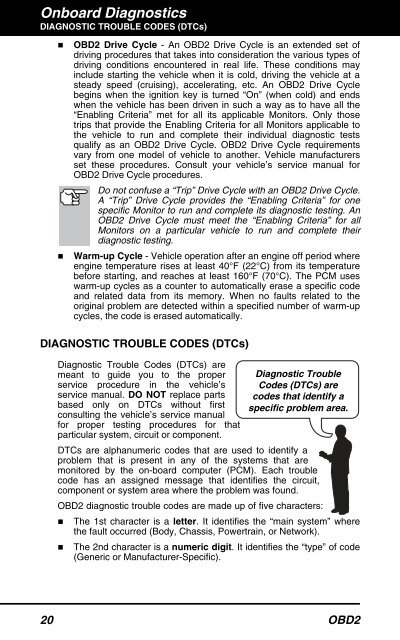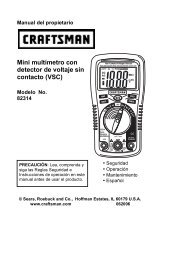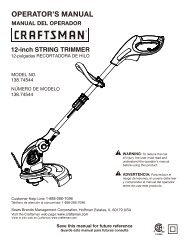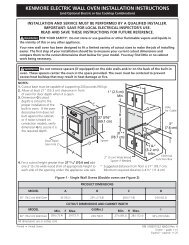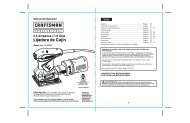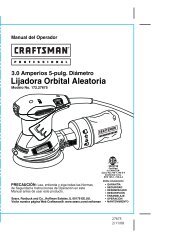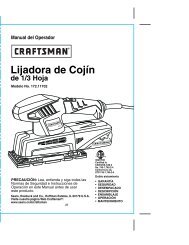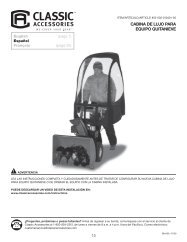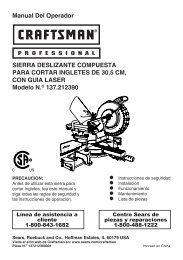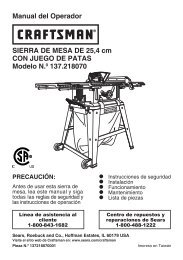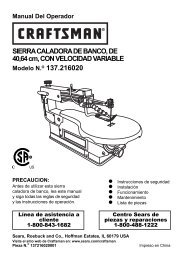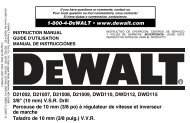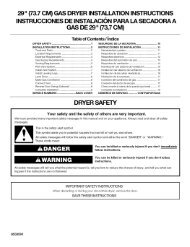CanOBD2 Diagnostic Tool - Sears
CanOBD2 Diagnostic Tool - Sears
CanOBD2 Diagnostic Tool - Sears
- TAGS
- diagnostic
- tool
- sears
- c.sears.com
You also want an ePaper? Increase the reach of your titles
YUMPU automatically turns print PDFs into web optimized ePapers that Google loves.
Onboard <strong>Diagnostic</strong>s<br />
DIAGNOSTIC TROUBLE CODES (DTCs)<br />
� OBD2 Drive Cycle - An OBD2 Drive Cycle is an extended set of<br />
driving procedures that takes into consideration the various types of<br />
driving conditions encountered in real life. These conditions may<br />
include starting the vehicle when it is cold, driving the vehicle at a<br />
steady speed (cruising), accelerating, etc. An OBD2 Drive Cycle<br />
begins when the ignition key is turned “On” (when cold) and ends<br />
when the vehicle has been driven in such a way as to have all the<br />
“Enabling Criteria” met for all its applicable Monitors. Only those<br />
trips that provide the Enabling Criteria for all Monitors applicable to<br />
the vehicle to run and complete their individual diagnostic tests<br />
qualify as an OBD2 Drive Cycle. OBD2 Drive Cycle requirements<br />
vary from one model of vehicle to another. Vehicle manufacturers<br />
set these procedures. Consult your vehicle’s service manual for<br />
OBD2 Drive Cycle procedures.<br />
Do not confuse a “Trip” Drive Cycle with an OBD2 Drive Cycle.<br />
A “Trip” Drive Cycle provides the “Enabling Criteria” for one<br />
specific Monitor to run and complete its diagnostic testing. An<br />
OBD2 Drive Cycle must meet the “Enabling Criteria” for all<br />
Monitors on a particular vehicle to run and complete their<br />
diagnostic testing.<br />
� Warm-up Cycle - Vehicle operation after an engine off period where<br />
engine temperature rises at least 40°F (22°C) from its temperature<br />
before starting, and reaches at least 160°F (70°C). The PCM uses<br />
warm-up cycles as a counter to automatically erase a specific code<br />
and related data from its memory. When no faults related to the<br />
original problem are detected within a specified number of warm-up<br />
cycles, the code is erased automatically.<br />
DIAGNOSTIC TROUBLE CODES (DTCs)<br />
<strong>Diagnostic</strong> Trouble Codes (DTCs) are<br />
meant to guide you to the proper<br />
service procedure in the vehicle’s<br />
service manual. DO NOT replace parts<br />
based only on DTCs without first<br />
consulting the vehicle’s service manual<br />
for proper testing procedures for that<br />
particular system, circuit or component.<br />
<strong>Diagnostic</strong> Trouble<br />
Codes (DTCs) are<br />
codes that identify a<br />
specific problem area.<br />
DTCs are alphanumeric codes that are used to identify a<br />
problem that is present in any of the systems that are<br />
monitored by the on-board computer (PCM). Each trouble<br />
code has an assigned message that identifies the circuit,<br />
component or system area where the problem was found.<br />
OBD2 diagnostic trouble codes are made up of five characters:<br />
� The 1st character is a letter. It identifies the “main system” where<br />
the fault occurred (Body, Chassis, Powertrain, or Network).<br />
� The 2nd character is a numeric digit. It identifies the “type” of code<br />
(Generic or Manufacturer-Specific).<br />
20 OBD2


